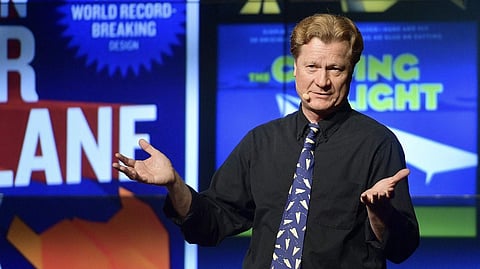

As kids, we have all flown paper airplanes and hoped they would stay afloat just a little farther to fly into the horizon or better yet break a world record. Here’s a real chance for you to do just that. On Sunday, April 5, 2020, at 7 pm, John Collins, who is called the Paper Airplane Guy, hosted an online workshop for people to join and learn how to make the farthest flying paper plane from the champion himself. The online workshop is an initiative by Atria University in Bengaluru. It was conducted on April 5 at 7 pm.
John found his place in the Guinness Book of World Records for designing and folding the world's farthest flying paper airplane in 2012. He has mastered both origami and aerodynamics and has spent several years creating these innovative flying wonders. We got an opportunity to interact with him before the workshop to know more about what's in store and paper airplanes.
Here's what transpired:
What was the online workshop be all about?
It’s a wonderful initiative. Not just this workshop, but, the series of online engagement efforts for students by Atria University is a great way to keep the learning especially in such fearful times when most students worry about what the future holds. The workshop is really a blend of my programmes for Science Fairs, Classrooms, and Museums. If you’ve seen my videos or television appearances, you’ll see all of those crazy planes fly, and we talk about how they work, take some questions from students as we go, and hopefully have a lot of fun. During this online workshop, students will learn how to make my world record paper airplane. We’ll also adjust the plane to do something a bit crazy, so students can experiment in real-time and get feedback.
Making paper planes has always been a game for kids, how did you make it into his profession?
Doing anything fun is kids’ activity, from riding a bike, swimming, surfing, to playing chess. We learn to do these things when we’re young, and we gain insight, knowledge, and even wisdom through doing them, if we persist as we grow. I have so many adults who tell me that learning to make the paper airplane I teach, marks the first time they’ve made a successful paper airplane. They are delighted to learn something new and then pass on that knowledge to friends and relatives. I don’t think that feeling of mastering something new ever gets old. I feel taking out time to play is really important for kids, and I also think we underestimate what it can do for adults as well. Learning about a paper airplane is also a kind of a game where you learn something new. Specifically, there’s physics involved and it’s a great way to teach students about the science of it.
What got you interested in making paper planes in the first place? What would you like to do if not this?
I was a successful television director, producer, and voice-over artist. I guess I would go back to that if I had to, but so far, this is looking pretty good. I’m an author, keynote speaker, and STEAM educator, who happens to throw paper airplanes to illustrate my stories.
There are different types of paper airplanes that you create, can you tell me about them and how they are made?
On a broader spectrum, there are darts, gliders, stunt planes, and follow foils. Darts are small-winged and fast; generally thought of as distance designs. Gliders have bigger wings and fly slower; generally thought of as duration designs. Stunt planes come in all shapes and sizes because they have something built into them that allows them to manipulate the airflow in a surprising way, resulting in a trick or 'stunt'. Follow foils ride a wave of air and can be flown for minutes at a time, once you learn how to pilot them. All designs share accurate folding, crisp creases, and perhaps the most important thing — attention to proper adjusting. People who think they can’t fold a good paper airplane usually have never learned how and why adjusting a plane makes it work.
Creating anything is considered as art, similarly, paper plane making is also an art, how would you say it can help children at an early age if they take it up seriously?
The world-renowned psychologist and cognitive development expert, Piaget would tell you manipulative learning is critical in a number of ways to childhood development. Paper folding, and therefore paper airplanes, are proven to increase 3D visualisation, memorisation, small motor skills, eye/hand coordination, direction following, and some gross motor skills. It’s an incredibly inexpensive laboratory for learning the underpinnings of how science works: hypothesis, experiment design, experiment trial, data collection, and conclusions. Science, specifically Physics, is built into the throw of every plane. And am glad to see Atria University’s approach to learning incorporates these effective learning methodologies.
How do you think children and adults can use their time at home now more productively?
I’m asked that a lot. Some people think that paper airplanes are going to replace video games or time spent looking at a screen of some kind. Well, maybe. That stuff is so interesting and fun that the best you can hope for is to get added to the mix. By default, paper planes might edge out some of that, because there are only so many hours in a day. But realistically, paper airplanes can’t replace video games. One of the things that make me happy is how much the paper airplane activity organically invites young and old to participate, and frequently together. Adults can teach kids, kids can teach adults, and it’s an area where particular skills come in handy — skills that generally have nothing to do with age. Any activity that invites everyone into the circle is great.
